Middle-East Industrial Gases Market Size
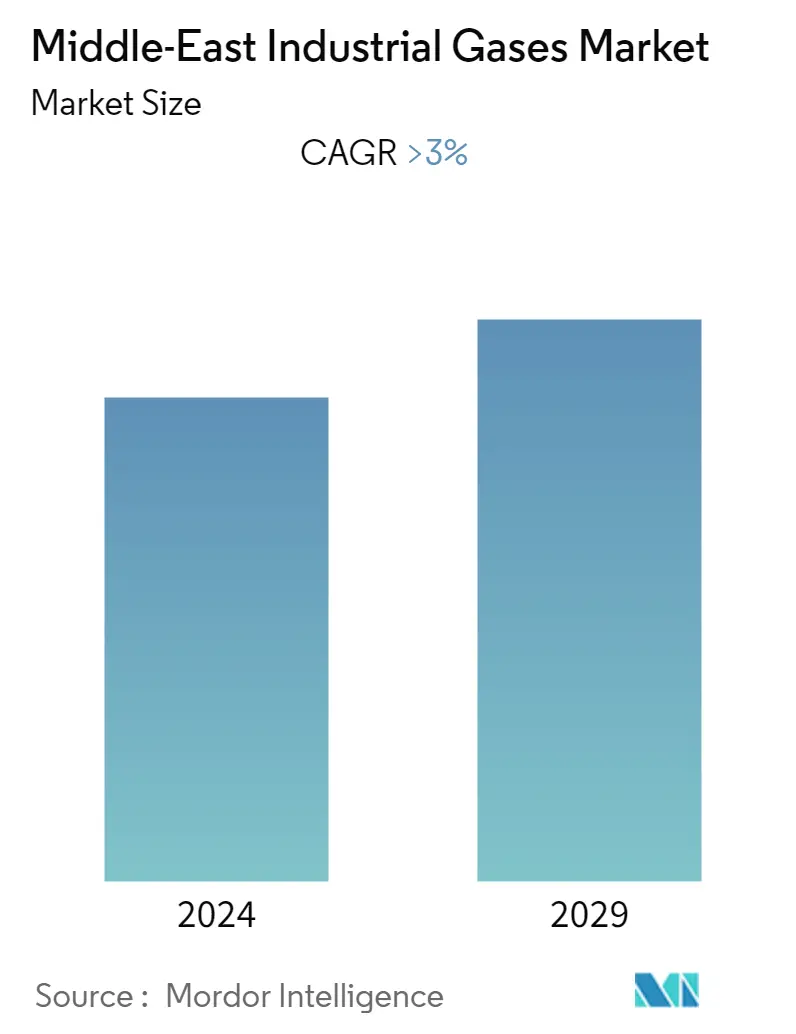
| Study Period | 2019 - 2029 |
| Base Year For Estimation | 2023 |
| Forecast Data Period | 2024 - 2029 |
| Historical Data Period | 2019 - 2022 |
| CAGR | 3.00 % |
| Market Concentration | High |
Major Players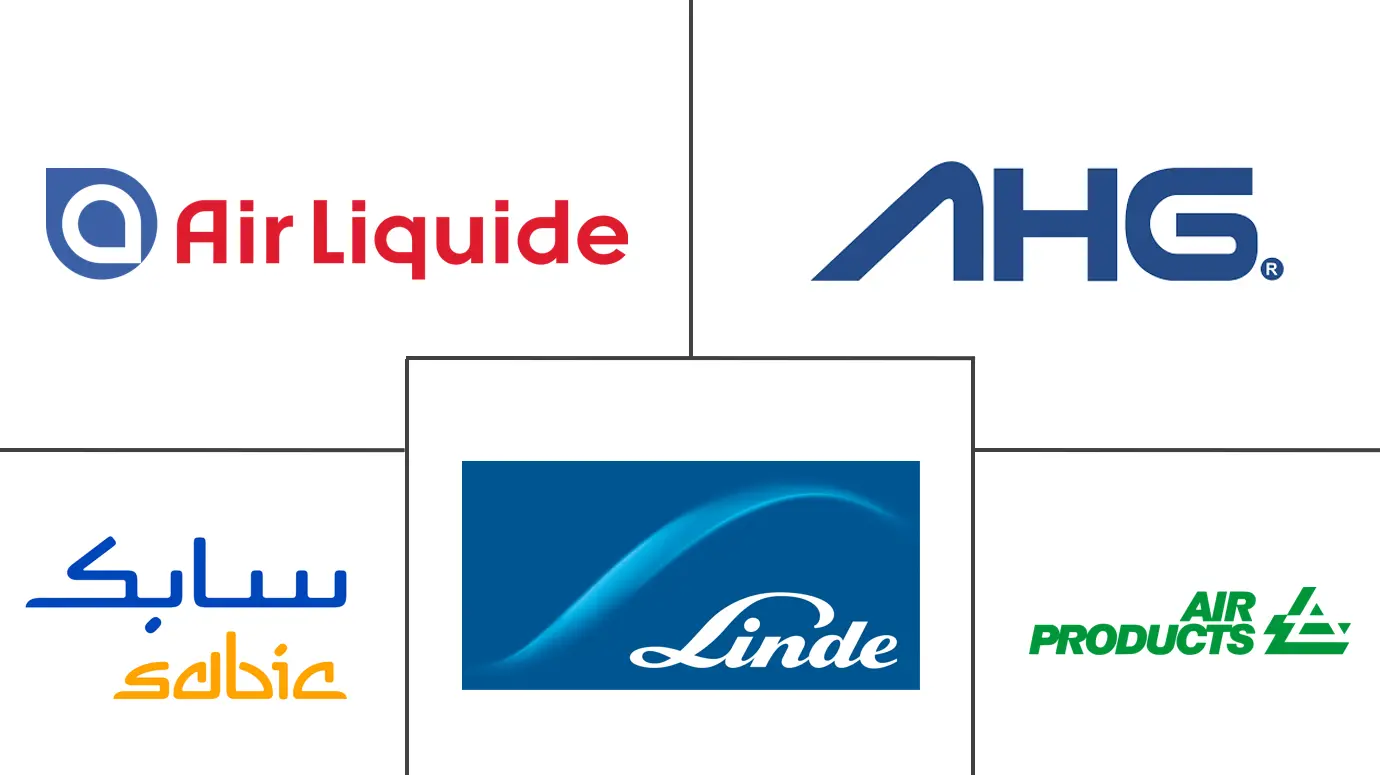
*Disclaimer: Major Players sorted in no particular order |
Need a report that reflects how COVID-19 has impacted this market and its growth?
Middle-East Industrial Gases Market Analysis
The Middle Eastern industrial gases market is estimated to reach 50.35 million tons by the end of this year. It is projected to reach 60.58 million tons in the next five years, registering a CAGR of 3.77% during the forecast period.
The COVID-19 pandemic affected several industries negatively. The lockdown in most countries in the region caused disruptions in industrial activities and freight transportation that disturbed the supply chain in nearly every end-user industry. However, the conditions started recovering in 2021, restoring the market's growth trajectory.
- Over the short term, growing demand from the oil and gas industry and the growing need for alternate energy sources are major factors driving the market's growth.
- However, the environmental regulations and safety issues concerning industrial gases are likely to restrain the market's growth.
- Nevertheless, the growing demand for low-carbon gases in the coming years will likely create lucrative growth opportunities for the market in the coming years.
- Saudi Arabia represents the region's largest industrial gas market and is likely to witness strong growth in demand on the back of increasing oil and gas production and refining and chemical production capacities.
Middle-East Industrial Gases Market Trends
Oil and Gas Industry to Dominate the Market
- Nitrogen and carbon dioxide are the two most common industrial gases used in upstream oil and gas activities. Nitrogen and carbon dioxide as bulk gases are used in huge quantities to extract and explore oil and natural gas with induced hydraulic fracturing, commonly known as fracking.
- Nitrogen is utilized in the drilling, workover, and completion phases of oil and gas wells and in pipeline pigging and purging. Nitrogen applications include well stimulation, injection and pressure testing, enhanced oil recovery (EOR), reservoir pressure maintenance, nitrogen floods, and inert gas lift, and it is used in both onshore and offshore applications.
- Carbon dioxide(CO2) is applied to a reservoir as a tertiary oil recovery method. CO2 services are also used for energized fluid fracturing (fracking) in conventional reservoirs for long-reach horizontal and vertical wells. Ammonia is also used in the oil and gas industry, with the gas used to neutralize acidic chemicals during the oil refining process.
- The Middle East is home to five of the top ten oil-producing countries, accounting for approximately 27% of global output. Many of the world's largest oil producers are in the Middle East, including Saudi Arabia, the United Arab Emirates, and Iraq.
- According to the Energy Institute Statistical Review of World Energy 2023, oil production in the Middle East in 2022 was 1441.6 million tons, 9.5% more than in 2021. On the other hand, gas production increased 5.4% from 3504 thousand barrels a day in 2021 to 3691 thousand barrels a day in 2022.
- The United Arab Emirates is one of the top ten oil producers in the world. Abu Dhabi is home to approximately 96% of the country's approximately 100 billion barrels of proven oil reserves, ranking sixth in the world.
- The Abu Dhabi National Oil Company (ADNOC) aims to increase the profitability of its upstream assets while also developing the oil resources required to meet projected increases in global oil demand.
- In November 2022, ADNOC's board of directors in Abu Dhabi approved a plan to expand the company's oil production capacity by 5 million barrels per day from 2030 to 2027. The UAE's hydrocarbon reserves increased by 2 billion storage tank barrels (STB) in oil and 1 trillion standard cubic feet (TSCF) in natural gas in 2022. The additional reserves will bring the UAE's reserves base to 113 billion STB of oil and 290 of the TSCF natural gas, ADNOC reported.
- Furthermore, Abu Dhabi National Oil Company (ADNOC) plans to spend USD 150 billion on investments over the next five years to advance its target of 5 million barrels of oil production capacity per day by 2027 on an improved market base.
- In January 2023, Kuwait announced the expansion of its gas manufacturing facility. The implementation of this project will help Kuwait to export propane and butane gas to global markets. The General Planning Director of Kuwait National Oil Company reported that implementing the fifth liquefied natural gas pipeline project aligns with the company's plans and future strategic goals regarding expanding gas production capacity.
- Owing to the increase in oil and gas production activities and several developments in progress, the demand for industrial gases from the oil and gas sector is likely to remain strong in the forecast period.
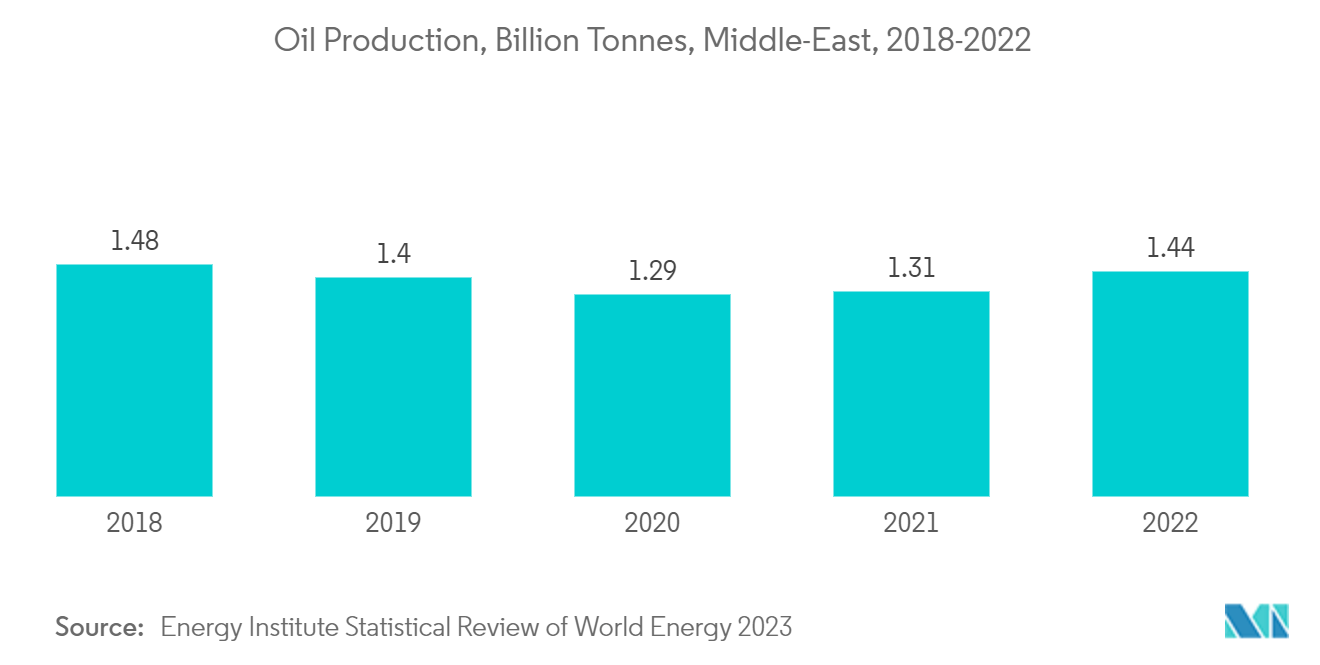
Saudi Arabia to Dominate the Regional Market
- Saudi Arabia is the largest consumer of industrial gases in the Middle Eastern region, courtesy of its oil and gas production and refining activities alongside major industrial construction.
- Saudi Arabia's interest in hydrogen is motivated primarily by the country's desire to ensure economic security. Hydrogen can help Saudi Arabia, the world's largest crude oil exporter, meet several key mandates of Saudi Vision 2030, including diversifying exports, leveraging existing supply chains to increase local content, and developing new industrial sectors.
- In July 2023, construction began for the largest green hydrogen project by NEOM Green Hydrogen Co. (NGHC) in Saudi Arabia. NEOM Green Hydrogen Co. (NGHC) is a joint venture of ACWA Power, Air Products, and NEOM. The project is expected to produce 600 tons of carbon-free hydrogen daily upon completion in 2026. The project attracted an investment of USD 500 billion.
- According to the Organization of Petroleum Exporting Countries (OPEC), Saudi Arabia owns about 17% of the world's proven oil reserves. In addition to oil, the kingdom's other natural resources include natural gas and iron ore.
- Saudi Arabia's Jizan refinery, managed by Aramco, operates at 400,000 barrels per day (b/d) with a capacity of 50 tonnes. When fully operational, the Jizan complex will process Arabian heavy and medium crude oil to produce up to 75,000 b/d of gasoline, 250,000 b/d of ultra-low sulfur diesel, and 90,000 b/d fuel for power plants.
- In February 2023, Saudi Aramco won approximately 90 project contracts over the next three years to facilitate a significant expansion of its upstream oil and gas production capacity. Between 2023 and 2025, Aramco has 66 projects on oil and gas processing and refining assets, 14 on pipelines and power distribution, and ten on civil infrastructure and security systems. According to Aramco, the 90 projects on the list are expected to require 12,000 kilometers of pipelines, 20,000 kilometers of cables, and 2.2 million cubic meters of concrete.
- As of September 2022, Saudi Arabia planned to build three steel projects worth SAR 35 billion (~USD 9.3 billion) to develop its industrial sector as part of the Kingdom's economic diversification agenda. The total production capacity of the project will bring it to 6.2 million tonnes, according to Saudi Arabia's Minister of Industry and Natural Resources.
- The Kingdom has also launched the National Steel Sector Structural Plan, which includes 41 recommendations to promote and sustain the steel sector. This includes reviewing and approving 16 policies and laws and long-term solutions such as establishing an iron academy and research and development center to increase the efficiency of Saudi factory operations and high-quality work.
- Considering the major developments in the oil and gas sector, coupled with increasing industrial activities in line with the Saudi 2030 Vision, the demand for industrial gases is forecasted to grow steadily in the country.
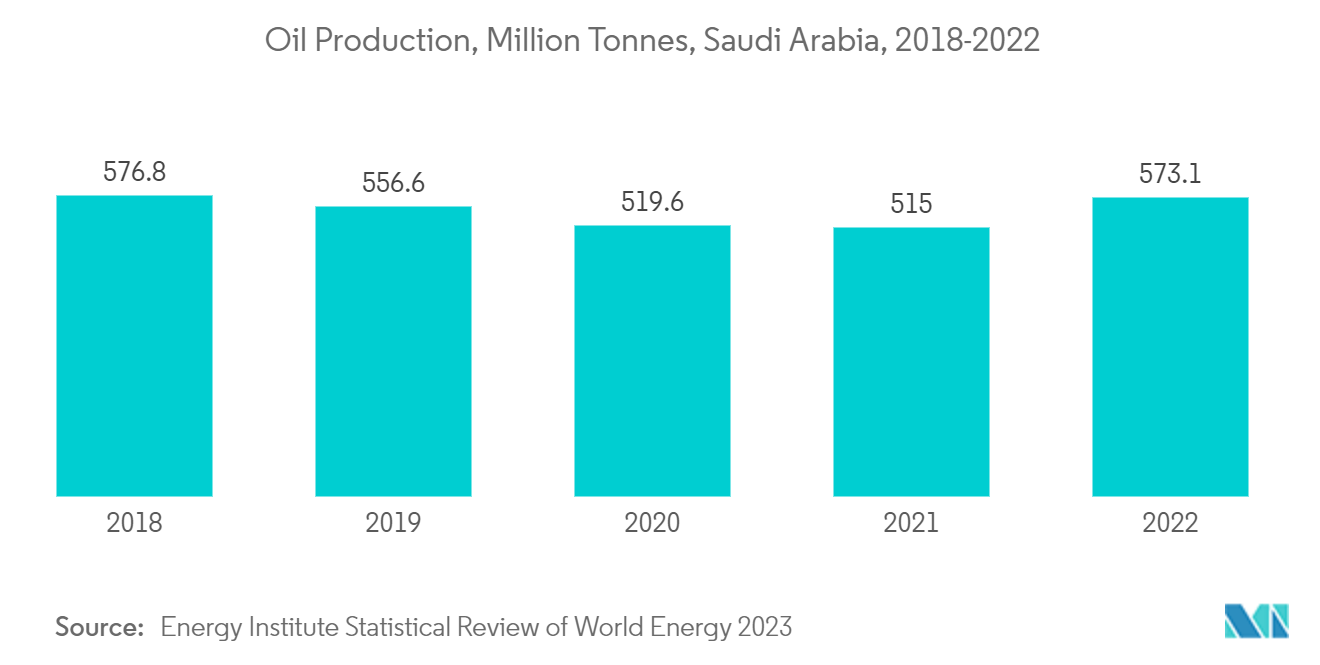
Middle-East Industrial Gases Industry Overview
The Middle Eastern industrial gases market is partially consolidated in nature. The major players include (not in any particular order) Linde PLC, Air Liquide, Air Products and Chemicals Inc., SABIC, and Abdullah Hashim Industrial Gases & Equipment (AHG).
Middle-East Industrial Gases Market Leaders
-
Linde PLC
-
Air Liquide
-
SABIC
-
Abdullah Hashim Industrial Gases & Equipment (AHG)
-
Air Products and Chemicals Inc.
*Disclaimer: Major Players sorted in no particular order
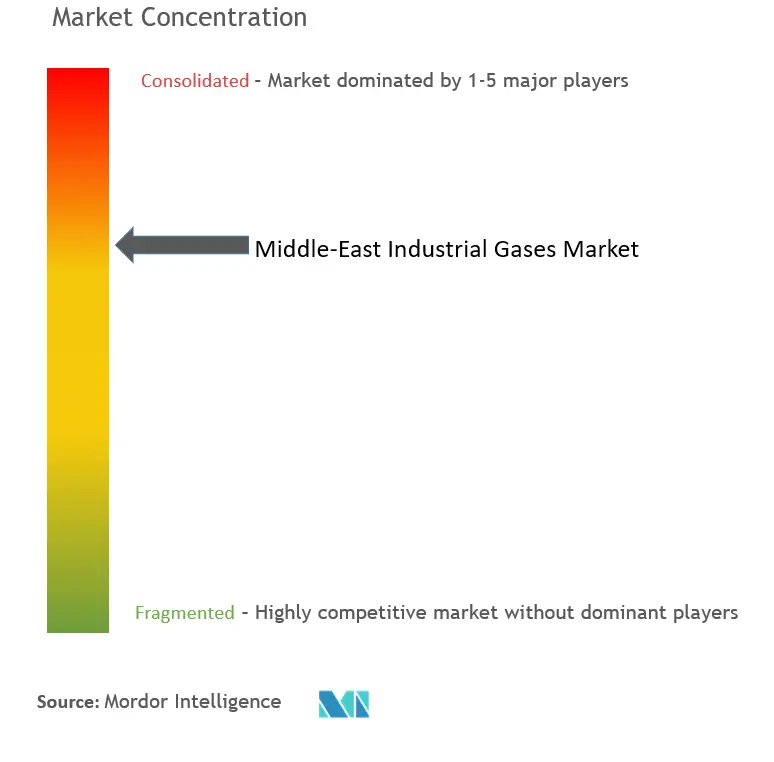
Middle-East Industrial Gases Market News
- December 2022: Air Products announced that it had signed an agreement with Saudi Ground Services (SGS) to demonstrate Hydrogen for Mobility at Dammam Airport, Saudi Arabia. Saudi Ground Services provides a wide range of ground handling services throughout the entire network of airlines in Saudi Arabia, from passenger services and baggage handling to fleet solutions and cargo services.
- January 2022: Air Products completed the acquisition of Air Liquide's industrial merchant gases business in the United Arab Emirates, which includes liquid bulk, packaged gases, and specialty gases, and also acquired Air Liquide's majority share in Middle East Carbon Dioxide W.L.L. (MECD), for a liquid carbon dioxide production facility in Bahrain.
Table of Contents
1. INTRODUCTION
- 1.1 Study Assumptions
- 1.2 Scope of the Study
2. RESEARCH METHODOLOGY
3. EXECUTIVE SUMMARY
4. MARKET DYNAMICS
-
4.1 Drivers
- 4.1.1 Increasing Demand from the Oil and Gas Industry
- 4.1.2 Growing Need for Alternate Energy Sources
- 4.1.3 Other Drivers
-
4.2 Restraints
- 4.2.1 Environmental Regulations and Safety Issues
- 4.2.2 Other Restraints
- 4.3 Industry Value Chain Analysis
-
4.4 Industry Attractiveness - Porter's Five Forces Analysis
- 4.4.1 Bargaining Power of Suppliers
- 4.4.2 Bargaining Power of Buyers
- 4.4.3 Threat of New Entrants
- 4.4.4 Threat of Substitute Products and Services
- 4.4.5 Degree of Competition
5. MARKET SEGMENTATION (Market Size in Volume)
-
5.1 By Product Type
- 5.1.1 Nitrogen
- 5.1.2 Oxygen
- 5.1.3 Carbon dioxide
- 5.1.4 Hydrogen
- 5.1.5 Helium
- 5.1.6 Argon
- 5.1.7 Ammonia
- 5.1.8 Methane
- 5.1.9 Propane
- 5.1.10 Butane
- 5.1.11 Other Product Types (Fluorine and Nitrous oxide)
-
5.2 By End-user Industry
- 5.2.1 Chemical Processing and Refining
- 5.2.2 Electronics
- 5.2.3 Food and Beverage
- 5.2.4 Oil and Gas
- 5.2.5 Metal Manufacturing and Fabrication
- 5.2.6 Medical and Pharmaceutical
- 5.2.7 Automotive and Transportation
- 5.2.8 Energy and Power
- 5.2.9 Other End-user Industries (Water Treatment and Environmental Protection)
-
5.3 By Geography
- 5.3.1 Saudi Arabia
- 5.3.2 United Arab Emirates
- 5.3.3 Qatar
- 5.3.4 Rest of Middle East
6. COMPETITIVE LANDSCAPE
- 6.1 Merger & Acquisitions, Joint Ventures, Collaborations, and Agreements
- 6.2 Market Share (%)**/Ranking Analysis
- 6.3 Strategies Adopted by Leading Players
-
6.4 Company Profiles
- 6.4.1 Abdullah Hashim Industrial Gases & Equipment (AHG)
- 6.4.2 Air Liquide
- 6.4.3 Air Products and Chemicals Inc.
- 6.4.4 BASF SE
- 6.4.5 Buzwair Industrial Gases Factories
- 6.4.6 Dubai Industrial Gases
- 6.4.7 Gaschem Kuwait
- 6.4.8 Gulf Cryo
- 6.4.9 Linde PLC
- 6.4.10 SABIC
- 6.4.11 Sipchem (Sahara International Petrochemical Company)
- *List Not Exhaustive
7. MARKET OPPORTUNITIES AND FUTURE TRENDS
- 7.1 Growing Demand for Low-Carbon Gases in the Coming Years
- 7.2 Other Opportunities
Middle-East Industrial Gases Industry Segmentation
Industrial gases are produced in relatively large quantities by gas manufacturing companies for use in various industrial manufacturing processes. These gases are sold to other enterprises and industries, including oil and gas, petrochemicals, chemicals, power, mining, steelmaking, metals, environmental protection, medicine, pharmaceuticals, biotechnology, food, water, fertilizers, nuclear power, and electronics.
The Middle Eastern industrial gases market is segmented by product type, end-user industry, and geography. By product type, the market is segmented into nitrogen, oxygen, carbon dioxide, hydrogen, helium, argon, ammonia, methane, propane, butane, and other types (fluorine and nitrous oxide). By end-user industry, the market is segmented into chemical processing and refining, electronics, food and beverage, oil and gas, metal manufacturing and fabrication, medical and pharmaceutical, automotive and transportation, energy and power, and other end-user industries (water treatment and environmental protection). The report also covers the market size and forecasts for the Middle Eastern industrial gases market in three countries across the Middle Eastern region.
For each segment, the market sizing and forecasts are provided on the basis of volume (tons).
| By Product Type | Nitrogen |
| Oxygen | |
| Carbon dioxide | |
| Hydrogen | |
| Helium | |
| Argon | |
| Ammonia | |
| Methane | |
| Propane | |
| Butane | |
| Other Product Types (Fluorine and Nitrous oxide) | |
| By End-user Industry | Chemical Processing and Refining |
| Electronics | |
| Food and Beverage | |
| Oil and Gas | |
| Metal Manufacturing and Fabrication | |
| Medical and Pharmaceutical | |
| Automotive and Transportation | |
| Energy and Power | |
| Other End-user Industries (Water Treatment and Environmental Protection) | |
| By Geography | Saudi Arabia |
| United Arab Emirates | |
| Qatar | |
| Rest of Middle East |
Frequently Asked Questions
What is the current Middle-East Industrial Gases Market size?
The Middle-East Industrial Gases Market is projected to register a CAGR of greater than 3% during the forecast period (2024-2029)
Who are the key players in Middle-East Industrial Gases Market?
Linde PLC, Air Liquide, SABIC, Abdullah Hashim Industrial Gases & Equipment (AHG) and Air Products and Chemicals Inc. are the major companies operating in the Middle-East Industrial Gases Market.
What years does this Middle-East Industrial Gases Market cover?
The report covers the Middle-East Industrial Gases Market historical market size for years: 2019, 2020, 2021, 2022 and 2023. The report also forecasts the Middle-East Industrial Gases Market size for years: 2024, 2025, 2026, 2027, 2028 and 2029.
Middle-East Industrial Gases Industry Report
Statistics for the 2024 Middle-East Industrial Gases market share, size and revenue growth rate, created by Mordor Intelligence™ Industry Reports. Middle-East Industrial Gases analysis includes a market forecast outlook to for 2024 to 2029 and historical overview. Get a sample of this industry analysis as a free report PDF download.

